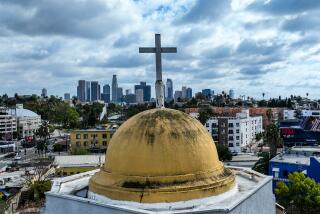New Church Blends Two Cultures in Santa Ana
- Share via
The sanctuary of Santa Ana’s new Our Lady of La Vang Church was designed to give worshipers a transcendent experience by mixing influences from East and West.
In the center of the four-cornered building, a sleek altar sits under a large dome. Surrounding it are blond oak pews that seat more than 1,000. Light streams in from many windows, bathing the worship space.
“It’s a round structure upon a square structure,” said Father Joseph Nguyen, pastor of the Roman Catholic parish that will offer Masses starting next week in English, Spanish and Vietnamese. “The round and square in the East symbolizes heaven and earth, a harmony. In the West, the round represents eternity and perfection, [while] the square represents justice and strength.”
Today is the official dedication of the 16,000-square-foot church, with Bishop of Orange Tod D. Brown expected to sprinkle holy water on its walls and rub oil on its altar.
The structure is Orange County’s first circular Catholic church, its first with a Vietnamese name and the first in the diocese designed specifically with multiculturalism in mind.
Nguyen said most previous churches were built in mostly white communities, and slowly, when migration took place, the churches took on the character of the new group.
“We’re very excited and hope this will truly be a model of cooperation and community-building in honor of Our Lady and for the glory of God,” he said.
The birthing of the new parish was not without pain.
In 2001 the diocese broke ground on the $9.3-million project on Harbor Boulevard near 1st Street. The new parish will absorb nearby Our Lady of Lourdes, which will be closed -- a move protested by many Latinos who believe Brown moved and renamed their church to cater to wealthier Vietnamese Catholics.
At one point the tensions grew so high between Brown and the pastor of Our Lady of Lourdes that the bishop halted construction of the building until the priest agreed to step down.
“The Vietnamese Catholic community is the second-largest community [behind Latinos] in the Diocese of Orange,” the bishop explained at the time. “Yet they were the only ones who didn’t have the privilege of having a parish named after their patron -- or, in this case, patroness.”
Our Lady of La Vang refers to a vision of Mary said to have first appeared in Vietnam’s La Vang forest in 1798 and which protected Vietnamese Catholics from persecution. A church by that name, built in 1901, was rebuilt in 1928 and eventually destroyed in the summer of 1972 during the Vietnam War. Our Lady of La Vang Church houses a statue of the saint.
“I’ve been waiting for this, and now it’s like a dream come true,” said Minh Yen Vu, 53, who hosts a Vietnamese-language radio program called Queen of Peace.
Planners say they incorporated elements of both cultures into the new building’s design.
The round-on-square structure, for instance, in addition to its symbolic significance to Vietnamese, resembles the ancient Iberian and Roman style familiar to Latinos. And the exterior trilevel appearance, topped with a cross, is a traditional Catholic design.
“This is a one-of-a-kind project,” said Jim Corcoran, the Newport Beach architect who designed the church. “The idea was to get everyone in close.”
Not all Latino parishioners, however, are sold on that idea.
Juanita Vega, 74 and a parish member since 1950, said she was disappointed by the changes that she said had destroyed a way of life for her and other longtime Latino congregants.
For more than half a century, Vega said, the old 200-seat church was a center of religious and social activities for dozens of Spanish-speaking families in the neighborhood.
“We had a reason for going there almost every day,” she said, “either to pray or to help at the church. All this is gone. I’m not happy about it; it’s like they took away 50 years of my life.”
Vega said she and her husband and many other Latino families were looking for a new parish to join.
Oselia Maldonaldo, who expressed misgivings in 2001, says she’s now trying her best to adapt.
“I’ve been a little grumpy lately,” she said last week, because “it’s a big, big change. There are just a few Hispanics left -- people slowly left because they didn’t like the change. To this day, people say the Vietnamese took away our church.”
None of which fazes Nguyen.
“This is their church,” he said of the parish’s two dominant cultures, and “their community. We have just finished the beginning.”
*
Times staff writer H.G. Reza contributed to this report.
More to Read
Sign up for Essential California
The most important California stories and recommendations in your inbox every morning.
You may occasionally receive promotional content from the Los Angeles Times.













